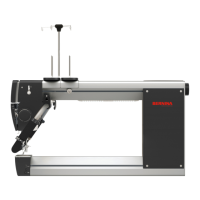Preparing to work on a quilt
57
5.2 Basting quilt layers
To prevent the quilt from shifting during quilting, it must be basted on the top edge and on both sides. Baste
the quilt as close to the edge as possible so that the basting stitches are not visible after the quilt is bordered.
Basting the upper edge
> If mechanical channel locks are fitted, block the vertical channel locks so that the machine can only be
moved to the right and left.
> Select Mode BSR3.
> Select SPI2 or SPI4
> Start at the upper left corner of the quilt.
> Pull up the bobbin thread and secure.
> Baste the upper edge slowly and carefully.
> At the end, secure, pull up the bobbin thread, an cut all threads.
Basting the sides
> If mechanical channel locks are fitted, block the horizontal channel locks so that the machine can only be
moved to the up and down.
> Select Mode BSR3.
> Select SPI2 or SPI4
> Start at the upper left and right corners.
> Pull up the bobbin thread and secure.
> Baste both sides slowly and carefully one after the other until the machine hits the rail.
> At the end, secure, pull up the bobbin thread, an cut all threads.
> Each time after each of the quilt, baste both sides until the machine hits the rail.
5.3 Sewing sample
Create sewing samples, e.g. to determine the optimum thread tension or to try out various stitch lengths.
You might also want to practice a pattern before you sew it onto the quilting project. Sewing samples are
excellent for this.
Always use the same materials for the sewing sample that you will be using for your quilting project. Only in
this way can you gage the settings correctly.
If you try out various settings, you can write the set values directly onto the sewing samples. You can keep
sewing samples labeled like this as a reference for future projects.

